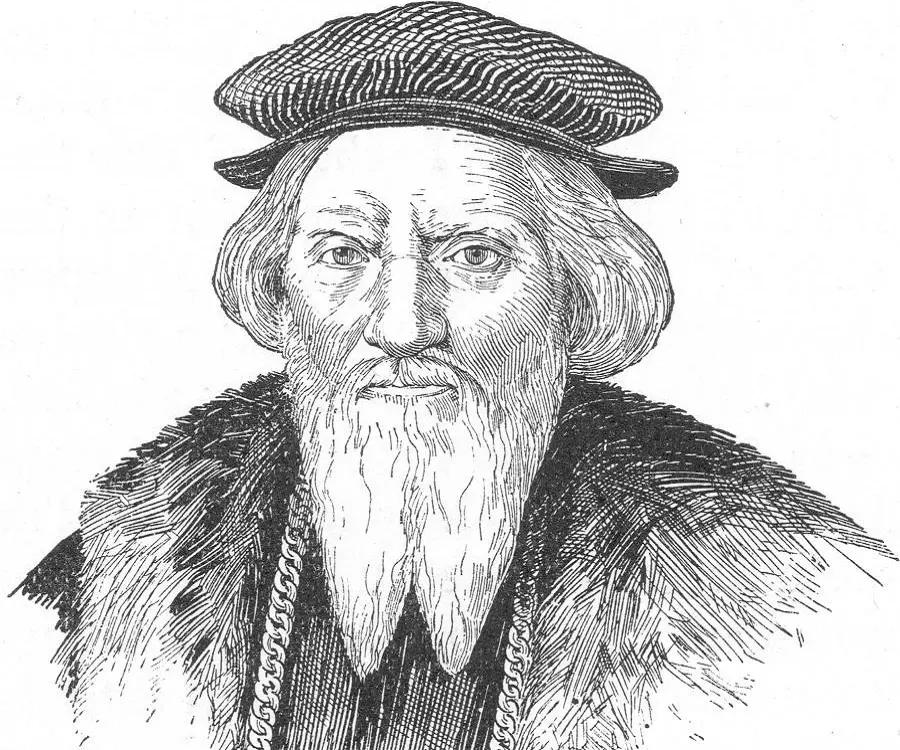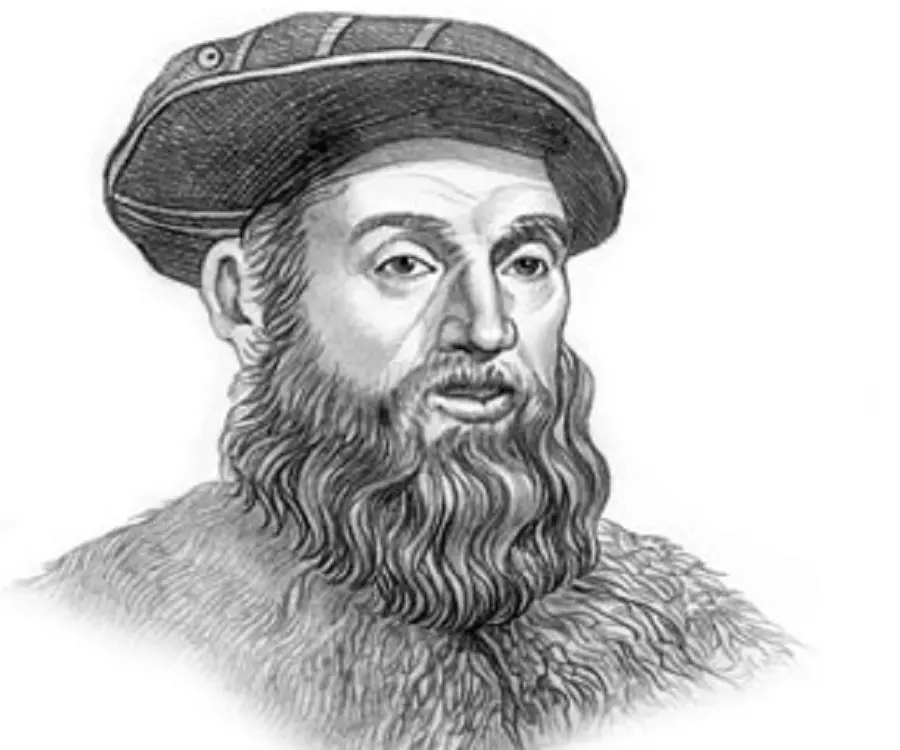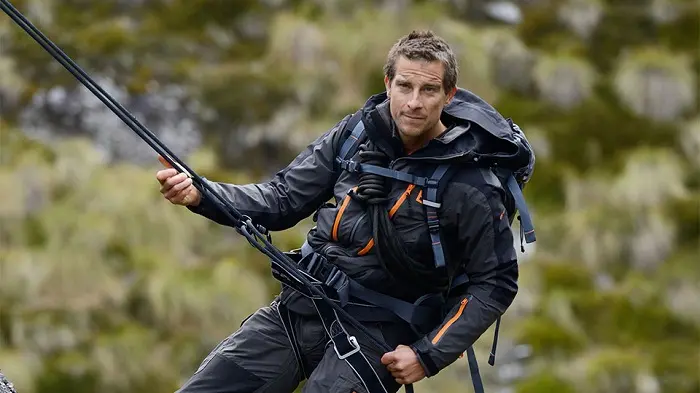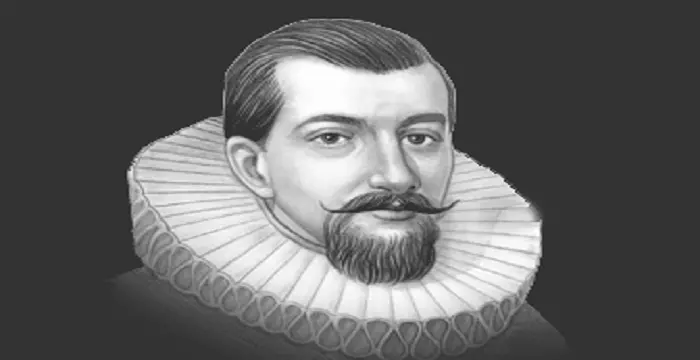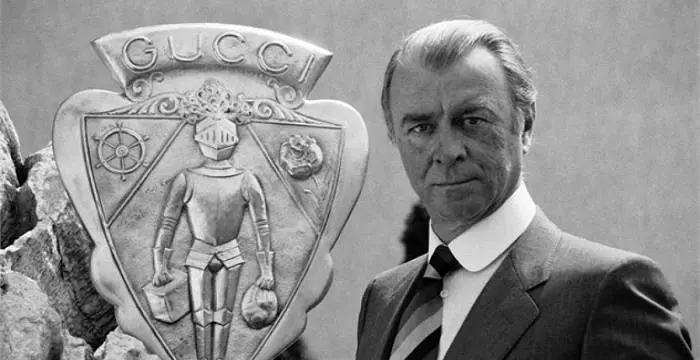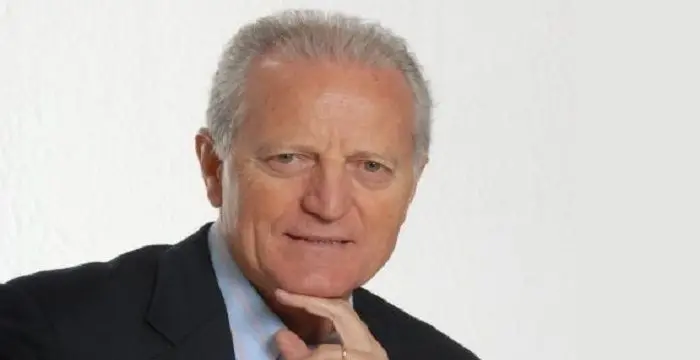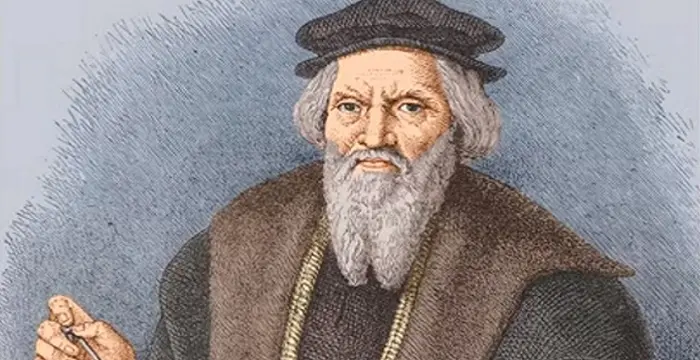
John Cabot - Explorers, Birthday and Family
John Cabot's Personal Details
John Cabot was an Italian navigator and explorer who was the first European to discover the coast of North America
| Information | Detail |
|---|---|
| Birthday | 1450 |
| Died on | January 1, 1508 |
| Nationality | Italian |
| Famous | Miscellaneous, Explorers |
| Spouses | Mattea Cabot |
| Siblings | Piero Caboto |
| Childrens | Ludovico Cabot, Sancius Cabot, Sebastian Cabot |
| Birth Place | Castiglione Chiavarese, Republic of Genoa |
| Religion | Catholicism |
| Gender | Male |
| Father | Guilo Caboto |
| Born in | Castiglione Chiavarese, Republic of Genoa |
| Famous as | Explorer |
| Died at Age | 58 |
// Famous Miscellaneous
Jason Simpson
Jason Simpson is the son of former NFL running back, broadcaster and actor O. J. Simpson. Check out this biography to know about his childhood, family, life, and little known facts about him.
Melissa Brim
Melissa Brim is the ex-girlfriend of former professional boxer Floyd Mayweather Jr. Check out this biography to know about her birthday, childhood, family life, achievements and fun facts about her.
Joyce Meyer
Joyce Meyer is a Christian author and speaker. This biography provides detailed information about her childhood, life, achievements, works & timeline
John Cabot's photo
Who is John Cabot?
John Cabot was an Italian navigator and explorer who was the first European to discover the coast of North America. In May 1497, with the help of English King Henry VII, Cabot decided to sail west from Bristol to find out a direct route to Asia. In June, he discovered a land and named it Newfoundland. At that time, he believed it was Asia and claimed it for England. After returning to England, he planned another voyage and began his next expedition. In May 1498, he set out on a voyage along with a fleet of four or five ships, to discover Japan. It is believed that Cabot reached North America but he never managed to return back. Cabot set out on number of voyages in his lifetime. The fate of his last expedition is unknown and many studies have been undertaken to understand the final voyage of Cabot. Historian, Alwyn Ruddock, had been working on Cabot and his era for 35 years. She had certain claims about Cabot’s final voyage and she believed that Cabot and his ship successfully returned to England in 1500. On the occasion of 500th anniversary of Cabot’s expedition, Canadian as well as British government elected Cape Bonavista, Newfoundland, as his first landing site. However, few other locations too have been proposed.
// Famous Explorers
Marco Polo
Marco Polo was the legendary Italian merchant, explorer and traveler, who travelled to China and worked under emperor, Kublai Khan. Read this biography to learn more about his profile, childhood, life and timeline.
Bear Grylls
Bear Grylls is an adventurer popularly known for his bizarre survival tactics in reality television series Man vs. Wild. This biography provides detailed information about his childhood, profile, career and timeline.
Henry Hudson
Henry Hudson was an early 17th century English navigator and explorer. This biography of Henry Hudson provides detailed information about his childhood, life, achievements, works & timeline
Childhood & Early Life
John Cabot was born in Genoa, Italy somewhere around 1450. His father, Giulio Caboto, was a spice merchant. John Cabot had a brother named Piero.
When Cabot was 11 years of age, he learned sailing and navigation from Italian seamen and merchants. In 1471, Cabot got accepted by a religious confraternity of St John the Evangelist. This was one of city’s prestigious confraternities.
Later Life
In 1476, he gained full Venetian citizenship and was eligible for maritime trade. This also included the trade to the eastern Mediterranean which was the main source of Venice’s wealth.
One of the documents that dates back to 1483 suggests that he sold a slave in Crete whom he had met in the territories of the Sultan of Egypt, most of which now comprises of Israel, Syria and Lebanon.
Cabot gained more knowledge of origins of oriental (West Asia) merchandise due to the Mediterranean trade. This helped him in dealing better with spices and silks than most Europeans did at that time.
In November 1488, Cabot got into financial trouble and had to leave Venice due to his debts. At that time, he moved to Valencia, Spain, but his creditors tried to arrest him by sending “a letter of recommendation to justice”.
When he was in Spain, he changed his name to “John Cabot Montecalunya” and made some plans for improving the harbour. Unfortunately, these proposals got rejected.
In the early of 1494, he moved to Seville, where he was on contract to build, and work on the construction of a stone bridge over the Guadalquivir River for five months. However, on 24 December 1494, this projected too was shelved.
Following this, Cabot asked for support from Seville and Lisbon for an Atlantic expedition. After this, he moved to London in search of some funds and political support. In the mid-1495, he is believed to have reached England.
Cabot led on several expeditions on commission to European nations like all other Italian explorers. Many historians believe that on his arrival to England, Cabot left for Bristol, which was a major maritime center to seek financial help.
The royal patent of John Cabot stated that all his expeditions must have begun from Bristol, which means his financial supporters were from the same city. Historian Ruddock claimed to have found evidence of the same.
Ruddock had suggested that a patron named Father Giovanni Antonio de Carbonariis who was a friar was a deputy to a tax collector, Adriano Castellesi. It is believed that Carbonariis accompanied Cabot on his 1498 expedition. Also, the friar introduced Cabot to King Henry VII.
Cabot went to Bristol to prepare for his voyage since it was the second-largest seaport in England. The details about Cabot’s first voyage are obscure since it wasn’t recorded properly.
Some historians believe that in 1496, Cabot made a voyage with one ship from Bristol. However, he was forced to turn back because of short supply of food, bad weather and dispute with his crew.
His second voyage was in May 1497 and its information is derived from four short letters and an entry made in 1565 chronicle of the city of Bristol. The chronicle entry for 1496/7 speaks about the voyage that was made on St. John the Baptist’s Day with Cabot’s ship Matthew.
In 1497, one more letter was written by a Bristol merchant, John Day, probably addressed to Christopher Columbus speaks about Cabot’s second expedition. Moreover, Ruddock claimed to have discovered another piece of letter which was written on 10 August 1497. But this letter is yet to be found.
It is believed that on June 24 1497, Cabot and his crew made a landing proceeding around Ireland and then north and west. The exact details about the landing place are unclear, but it is believed that it could be in southern Labrador, Newfoundland or Cape Breton.
Some also believe that on his expedition in 1497, Cabot and his crew seemed to have found abundance of new fishery. The Milanese ambassador to England reported that Cabot saw the sea was “swarming with fish, which could not be caught with a net, but in baskets”.
The fish was cod and its abundance on the Grand Banks laid down the foundation of fishing industry in Newfoundland.
After returning back to Bristol, Cabot met the King who rewarded him with £10 which was equivalent to two years’ pay. In December 1497, Cabot was awarded pension of £20 per year. He was also given new letter patent covering the voyage in 1498.
In May 1498, John Cabot left Bristol with five ships and 300 crew members on another voyage. The ships had sufficient provisions and some samplings of cloth, lace points and other “trifles” which suggests they were planning to indulge in trade.
Out of the five ships, one of the ships was disabled and had to sail to Ireland, while the other ships continued their sail. After this, the fate of John Cabot and his ships is unknown. Some believe they were lost at sea for many days.
While the historian Ruddock suggested that Cabot and his fleet returned back to England in 1500. Some historians also suggest that Cabot explored the Canadian coast and stayed at Newfoundland and founded a mission with the help of a priest.
On his 500th anniversary expeditions, government of UK and Canada designated Cape Bonavista as his ‘’official’’ landing place. In 1997, Queen Elizabeth II is said to have greeted the replica of Matthew of Bristol.
Achievements
John Cabot is considered to be the first European to land in North America since the Vikings. He claimed the island of Newfoundland for the British.
Personal Life & Legacy
John Cabot got married in 1474 to a girl named Mattea. The couple had three sons: Ludovico, Sancto and Sebastiano. Cabot’s son, Sebastinao, followed his father’s path and became an explorer.
It’s not clear, when and how John Cabot died. The last time Cabot was mentioned was in 1508-1509 when he set out on expedition led by his son Sebastiano. Nothing is certain after that; he might have died during the journey or perhaps after returning from the journey.
A tower, ‘Cabot Tower’ was raised in the memory of John Cabot in 1897 in St. John’s, Newfoundland, to celebrate the 400th anniversary of Cabot’s voyage.
In 1925, an Italian club, named Giovanni Caboto Club’ was started in Ontario named in his honour.
In Bristol’s Council House, a statue of John Cabot was erected in 1952.
John Cabot University, a small American liberal arts university, was established in his honour in Rome, Italy, in 1972.
Stephen Joyce made a bronze statue of Cabot in 1985 which is located at Bristol Harbourside.
A replica of Cabot’s ship Matthew has been made in Bristol. The ‘Matthew of Bristol’ was docked in Bristol to honour his 500th anniversary.
An academy has been formed under John Cabot’s name in Bristol, England.
There has been a Cabot Squares in London and Montreal, whereas John Cabot Road can be found in north Phoenix, Arizona.
The land that Cabot discovered has also honoured him by naming a street after him, Cabot Street in St. John’s, Newfoundland and Labrador.
Cabot’s bronze statue is standing tall at the Confederation Building, St. John’s. Furthermore, another bronze statue of Cabot is located at Cape Bonavista, Newfoundland.
Trivia
In Italy, he is known as Giovanni Caboto and in English he is known as John Cabot.
University of Bristol started The Cabot Project in 2009 to discover evidence about Ruddock’s claims and to undertake studies related to Cabot and his expeditions.
// Famous Italian peoples
Pietro Boselli
Pietro Boselli is an Italian model, engineer, teacher, and fitness athlete who became famous as the ‘world’s sexiest math teacher’. Check out this biography to know about his birthday, childhood, family life, achievements and fun facts about him.
Guccio Gucci
Guccio Gucci was a famous fashion designer from Florence, Italy, and the founder of the world-renowned fashion brand ‘Gucci.’ Check out this biography to know about his childhood, family, personal life, career, etc.
Santo Versace
Santo Domenico Versace is an Italian businessman and politician. Check out this biography to know about his birthday, childhood, family life, achievements, and fun facts about him.
John Cabot biography timelines
- // 1450John Cabot was born in Genoa, Italy somewhere around 1450. His father, Giulio Caboto, was a spice merchant. John Cabot had a brother named Piero.
- // 1471When Cabot was 11 years of age, he learned sailing and navigation from Italian seamen and merchants. In 1471, Cabot got accepted by a religious confraternity of St John the Evangelist. This was one of city’s prestigious confraternities.
- // 1474John Cabot got married in 1474 to a girl named Mattea. The couple had three sons: Ludovico, Sancto and Sebastiano. Cabot’s son, Sebastinao, followed his father’s path and became an explorer.
- // 1476In 1476, he gained full Venetian citizenship and was eligible for maritime trade. This also included the trade to the eastern Mediterranean which was the main source of Venice’s wealth.
- // 1483One of the documents that dates back to 1483 suggests that he sold a slave in Crete whom he had met in the territories of the Sultan of Egypt, most of which now comprises of Israel, Syria and Lebanon.
- // Nov 1488In November 1488, Cabot got into financial trouble and had to leave Venice due to his debts. At that time, he moved to Valencia, Spain, but his creditors tried to arrest him by sending “a letter of recommendation to justice”.
- // 24th Dec 1494In the early of 1494, he moved to Seville, where he was on contract to build, and work on the construction of a stone bridge over the Guadalquivir River for five months. However, on 24 December 1494, this projected too was shelved.
- // 1495Following this, Cabot asked for support from Seville and Lisbon for an Atlantic expedition. After this, he moved to London in search of some funds and political support. In the mid-1495, he is believed to have reached England.
- // 1496Some historians believe that in 1496, Cabot made a voyage with one ship from Bristol. However, he was forced to turn back because of short supply of food, bad weather and dispute with his crew.
- // 1497Some also believe that on his expedition in 1497, Cabot and his crew seemed to have found abundance of new fishery. The Milanese ambassador to England reported that Cabot saw the sea was “swarming with fish, which could not be caught with a net, but in baskets”.
- // 24th Jun 1497It is believed that on June 24 1497, Cabot and his crew made a landing proceeding around Ireland and then north and west. The exact details about the landing place are unclear, but it is believed that it could be in southern Labrador, Newfoundland or Cape Breton.
- // 10th Aug 1497In 1497, one more letter was written by a Bristol merchant, John Day, probably addressed to Christopher Columbus speaks about Cabot’s second expedition. Moreover, Ruddock claimed to have discovered another piece of letter which was written on 10 August 1497. But this letter is yet to be found.
- // Dec 1497 To 1498After returning back to Bristol, Cabot met the King who rewarded him with £10 which was equivalent to two years’ pay. In December 1497, Cabot was awarded pension of £20 per year. He was also given new letter patent covering the voyage in 1498.
- // 1498Ruddock had suggested that a patron named Father Giovanni Antonio de Carbonariis who was a friar was a deputy to a tax collector, Adriano Castellesi. It is believed that Carbonariis accompanied Cabot on his 1498 expedition. Also, the friar introduced Cabot to King Henry VII.
- // May 1498In May 1498, John Cabot left Bristol with five ships and 300 crew members on another voyage. The ships had sufficient provisions and some samplings of cloth, lace points and other “trifles” which suggests they were planning to indulge in trade.
- // 1500While the historian Ruddock suggested that Cabot and his fleet returned back to England in 1500. Some historians also suggest that Cabot explored the Canadian coast and stayed at Newfoundland and founded a mission with the help of a priest.
- // 1508It’s not clear, when and how John Cabot died. The last time Cabot was mentioned was in 1508-1509 when he set out on expedition led by his son Sebastiano. Nothing is certain after that; he might have died during the journey or perhaps after returning from the journey.
- // 1952In Bristol’s Council House, a statue of John Cabot was erected in 1952.
- // 1972John Cabot University, a small American liberal arts university, was established in his honour in Rome, Italy, in 1972.
- // 1997On his 500th anniversary expeditions, government of UK and Canada designated Cape Bonavista as his ‘’official’’ landing place. In 1997, Queen Elizabeth II is said to have greeted the replica of Matthew of Bristol.
John Cabot's FAQ
When was John Cabot died?
John Cabot was died at 1508-01-01
Which age was John Cabot died?
John Cabot was died at age 58
Where is John Cabot's birth place?
John Cabot was born in Castiglione Chiavarese, Republic of Genoa
What is John Cabot nationalities?
John Cabot's nationalities is Italian
Who is John Cabot spouses?
John Cabot's spouses is Mattea Cabot
Who is John Cabot siblings?
John Cabot's siblings is Piero Caboto
Who is John Cabot childrens?
John Cabot's childrens is Ludovico Cabot, Sancius Cabot, Sebastian Cabot
What is John Cabot's religion?
John Cabot's religion is Catholicism
Who is John Cabot's father?
John Cabot's father is Guilo Caboto
How famous is John Cabot?
John Cabot is famouse as Explorer




